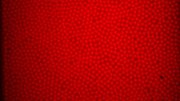Glassblowers can pull superheated glass fresh from a furnace just like taffy, blow bubbles in it, and fashion beautiful objects by manipulating it while it flows. But there is something curious about glass. Molten glass, as it cools and vitrifies, never actually becomes a solid in the classic sense: glass molecules never lock themselves into a crystalline structure the way a true solid would. Instead, they just stop flowing, like honey in the freezer. (In fact, when honey is very cold, it behaves like glass.)
When scientists want to understand the properties of glass--what makes it flow at one temperature and jam up at another, for example--they use as a model a colloidal fluid: a liquid filled with tiny particles, or colloids, suspended evenly in it (milk is a familiar example). By packing in more and more colloidal particles, they make the suspension denser and slower to mimic glass cooling.
“The behavior of single molecules in glass can’t be observed,” says Mallinckrodt professor of physics David Weitz, an expert in experimental soft condensed matter. “But the colloidal particles, which are a thousand times larger, can be seen under a microscope,” allowing researchers to visualize the behavior of glass at the molecular level under different conditions of temperature or stress.
But traditional colloidal models fail to mimic actual behavior at a certain point---solidifying or locking up rapidly in a way that true glass, which flows ever more slowly as it cools, does not. Weitz has therefore figured out how to create a colloid that behaves more like glass under near-solid, low-flow conditions by using soft, compressible particles made of gelatin in the fluid. The deformability of these Jell-O-like particles, says Weitz, is analogous to the vibrations and internal motions of real glass molecules, which are made of many atoms that allow them to fluctuate in size and shape.
Even without understanding the physics, experienced glassblowers know that once they start pulling glass in one direction, they can keep stretching it as it cools, but only by applying greater and greater force. The colloidal model, in its faithfulness to the way real glass flows, has allowed researchers to visualize the way individual molecules behave--to “see” how they deform as they literally slide past each other under pressure. This is a “huge insight,” says Weitz: that “a lot of what dominates” glass’s fascinating behavior depends “on the way squishy spheres pack together.”










